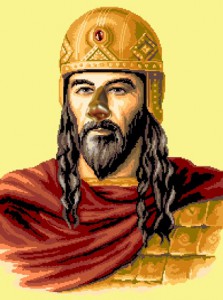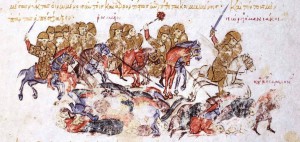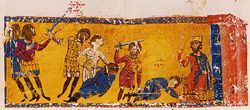What happened to the Bulgar Slayer’s novel?
 Calling all writers of historical fiction…
Calling all writers of historical fiction…
The other day I dusted off my copy of Colleen McCullough’s magnificent The First Man in Rome, a novel of historical fiction about Julius Caesar’s rise to power. That got me thinking- ‘considering that it lasted for a thousand years longer, where’s the historical fiction about the Byzantine Empire?’ Currently there isn’t a lot to choose from. The best is Harry Turtledove’s (writing under the pseudonym Turteltaub) Justinian, a fictionalized account of Justinian II’s vengeful return to power. Turtledove, who has a PHD in Byzantine studies, certainly picked an interesting subject- the late 7th century emperor was overthrown, had his nose cut off and was exiled to a distant part of the Black Sea. Undeterred, he started off the 8th century by having an artificial nose made of gold, escaped his captors, and snuck back into Constantinople through an unguarded Aqueduct to claim the throne again.
Aside from a young adult fiction about Anna Comnena, the only other author currently fighting the good fight is George Leonardos who in 2004 started a series about the final dynasty of Byzantium. That’s pretty slim pickings. So let me offer some suggestions to anyone looking for a good story to write down.
Emperor Nicephorus Phocas. His nickname was ‘The Pale Death of the Saracens’, he made Byzantium the most powerful empire of the Mediterranean, and he won nearly every battle he fought. And then he fell in love with a devastatingly beautiful woman who betrayed him, and he lost it all. Modern connection: relatives of his still live in Greece where multiple streets and at least one battleship are named in his honor.
General George Maniaches. This towering 11th century general was a throwback to the glory days of Byzantium. He commanded an army which included the legendary Norman adventurer William Iron-Arm and the Viking beserker Harald Hardrada (who would later invade England in 1066 and bring to a close the age of Viking invasions). The only thing he couldn’t control was his temper- when a rival seduced his wife and then got him fired, he had the man suffocated by smearing dung in his mouth, ears, and eyes; he then routed the imperial army but was killed in a fluke accident before he reached Constantinople. His death sealed the decline of Byzantine power in Italy. Modern connection: Sicily has several fortresses and a town named after him.
Praetorian Prefect Anthemius. This well-connected 3rd century Consul served two playboy emperors but was the real power behind the throne. Dedicated and hard working, he had to face the terrible Attila the Hun, and probably saved the east by deflecting him toward Rome. Modern connection: The impressive walls he built (the so-called ‘Theodosian Land Walls’) are the most visible secular reminders of Constantinople at the height of its power, and are rightly regarded as the most impressive defensive fortifications ever built. Though his ultimate fate is unknown, (sic transit gloria) for his efforts Anthemius has been called the ‘second founder of Constantinople’.
Princess Melissena. Riches to Rags… to riches? This mid-9th century princess was unbelievably well-connected, both to the hoi polloi of Byzantium and to foreign rulers like the Han Dynasty of China. In her time she was the most eligible bachelorette on the international stage. Unfortunately for her, it all came crashing down. Her grandfather abdicated, her father was castrated, and she was married off to a Viking member of the imperial guard. She travelled throughout western Europe on her way to her husband’s home, making a big impression especially in the courts of France. Modern Connection: She is possibly the inspiration for the Starbucks logo (http://bit.ly/db2pPa)
The list could go on for quite some time: Anthemius the architect of the Hagia Sophia, Basil the Macedonian- the ultimate rags to riches story, Empress Theophano- the femme fatale of Nicephorus Phocas, etc. The beauty of all of these is that they lived during the Byzantine ‘dark age’ which means it would be easy to remain faithful to the source material while having plenty of room to maneuver. Best of all, the main story arc is already written- all you have to do is provide the details. Anyone out there brave enough to take up the gauntlet?

